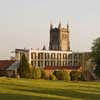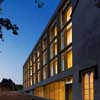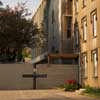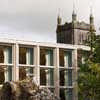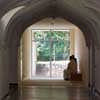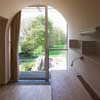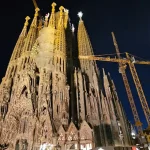Mount Melleray Ireland, Knockmealdown Mountains Building, Cappoquin, County Waterford Architecture
Mount Melleray, Ireland
County Waterford Building – Cistercian Monastery: Knockmealdown Mountains Architecture design by dhbArchitects
17 Aug 2011
Mount Melleray County Waterford Monastery
Design: dhbArchitects, Waterford
Photographs: Philip Lauterbach
Mount Melleray is a functioning monastery of Cistercian monks which forms part of the Irish national consciousness due to its historical and literary associations.
This project required the reordering of part of the monastery to provide a new accommodation wing for the monks. Until the advent of these new facilities, the monks, many of whom are elderly, lived scattered throughout the sprawling complex of mainly early 19th century buildings, with little or no amenities or modern services. The primary aim of the project was, by grouping them together under the one roof, to restore a sense of community and common purpose as well as provide basic comforts in self-contained rooms.
The basic unit of the project therefore is the room, or cell. There are 27 of these, expressed as bays 9 long by 3 high, and each has a view to the West and the Knockmealdown mountains, overlooking the verdant tranquility of the monastic gardens. Silence was a key component of the brief and several kinds of silence were required: The internal silence required for prayer, the external kind which is nuanced by the sound of nature; the silence which is focused by the sound of running water.
This new residential wing is located just inside the monastic enclosure, beside the newly refurbished guest house. It is built on the partially demolished remains of an earlier dormitory building and is connected to the cloister through a reorganised lobby area within the existing refectory. Along the internal approaches, the institutional feel of the existing building with its long corridors and poorly lit cloister has been softened and brightened by the introduction of glazed openings at the end of each axis, with views to the surrounding gardens.
Aspects of the monastic life such as rigour and community are expressed in the ordered layout of the cells and spaces while its contemplative nature is suggested by disconnecting the rooms from the ground plane and facing them westwards. The mountain on which the monastery is built is mirrored in the rising retaining wall outside the new chapel and chapter room and the Cistercians’ respect for the purifying properties of water is seen and heard in the flow of the mountain stream channeled along their edge.
The cells are vaulted, in a gesture to the early Christian tradition of Irish monastic architecture and the fully glazed western end of each is framed by an external screen wall providing privacy obliquely from the adjacent guest garden. This cantilevered screen is formed of massive prefabricated concrete elements, roughened by sandblasting, which catch light and shadow, expressing a materiality that is directly inspired by the monolithic ribbing of the abbey churches of Noirlac and Fontenay. The courtyard side is overlooked by the corridors to the cells and the common areas at infirmary level, the glazed curtain wall providing sequential glimpses to the tower and outbuildings.
This house replaces a derelict 1940’s single storey cottage (with associated out houses) which previously existed on the site.
The building is entered on foot at first floor level via a long stepped processional route to the front of the building. The façade to this stepped approach has been purposely left blank to focus the entrant to the point of entry whilst also weighting the propped cantilever appropriately. At entry level a hallway guides you to the open plan living kitchen and dining areas.
These areas are contained within a propped cantilevered volume, which hovers above the landscape below. A forest of red columns has been inserted below the cantilever, which conceptually grow out of the hillside. These columns ‘guard’ a pedestrian route, which leads you under the cantilever to the rear garden and living room deck at first floor level. Along this route one truly experiences the sheerness of the escarpment above.
Internally the hallway at main entry level has been conceived as an “internal street” the dimensions of which widen to the more public aspects of the plan and diminish along the points of entry to private bedrooms and bathrooms. A study at main entry level offers a taste of the internal experience prior to entry.
The roofscape is peppered with rooflights in an attempt to engage the user with the steep escarpment to the rear of the house. This affords the occupant vertical views of sky and foliage from the most private spaces within the house.
Mount Melleray images / information from FD
Location: Cappoquin, Republic of Ireland
Irish Architecture Designs
Contemporary Architecture in Ireland
Irish Architectural Designs – chronological list
Buildings in south east Ireland
House at Bogwest in Ireland, County Wexford
Design: Steve Larkin Architects
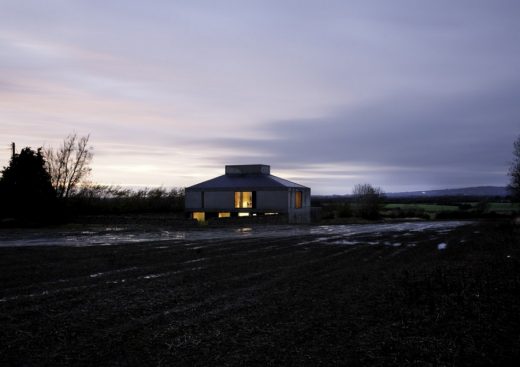
photo : Alice Clancy
House at Bogwest
The Butler Gallery, Kilkenny, County Kilkenny, province of Leinster, South-East Ireland
Design: McCullough Mulvin Architects
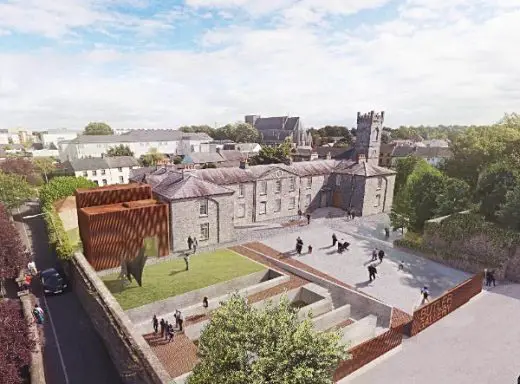
image © McCullough Mulvin Architects
Butler Gallery Building in Kilkenny
, Wexford, Republic of Ireland
Keith Williams Architects
Wexford Opera House
Aviva Stadium, Dublin
Populous
Aviva Stadium
Comments / photos for the Mount Melleray – County Waterford Building page welcome

